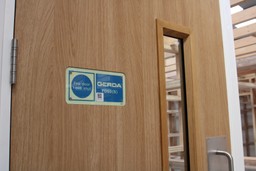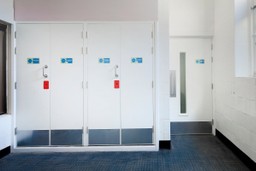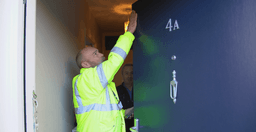Fire Doors for Commercial Buildings: Essential Requirements
Fire doors are an integral component of fire safety in commercial buildings, serving as barriers to contain the spread of fire, smoke, and toxic gases. In the UK, strict fire safety regulations, including the Regulatory Reform (Fire Safety) Order 2005 and Building Regulations Approved Document B, mandate that commercial properties install and maintain certified fire… Continue reading Fire Doors for Commercial Buildings: Essential Requirements
Fire doors are an integral component of fire safety in commercial buildings, serving as barriers to contain the spread of fire, smoke, and toxic gases. In the UK, strict fire safety regulations, including the Regulatory Reform (Fire Safety) Order 2005 and Building Regulations Approved Document B, mandate that commercial properties install and maintain certified fire doors. This article offers an introductory guide on fire door regulations for commercial buildings, as well as specifications, placement, and maintenance.
Key Takeaways
- Legal Requirements: Fire doors in commercial buildings must comply with UK regulations, including the Regulatory Reform (Fire Safety) Order 2005.
- Specifications: Doors must meet FD30 or FD60 fire resistance ratings and adhere to British Standards.
- Inspection and Maintenance: Fire doors require inspection every six months and consistent maintenance.
- Placement: Install fire doors along escape routes and compartmentation lines, per fire risk assessments.
- Identification: Clearly labelled signage on fire doors is required on both sides to aid in emergencies.
The Importance of Fire Doors in Commercial Buildings
Fire doors are designed to contain fires within a certain restricted or confined space (a ‘compartment’), preventing the spread of flames and smoke. By doing so, they protect escape routes, help contain structural damage, buying crucial time for occupants to evacuate and for emergency responders to arrive. In commercial spaces, where occupants might be unfamiliar with the building layout, fire doors are vital safety assets.Learn more about Gerda Security’s commercial sector solutions.
UK Fire Door Regulations: Ensuring Compliance
Regulatory Framework
In the UK, fire door installation and maintenance in commercial buildings are governed by two main sets of regulations:
- Regulatory Reform (Fire Safety) Order 2005: This legislation requires that every commercial property take adequate fire safety precautions.
- Building Regulations Approved Document B: Specifies fire safety standards for building design and the use of fire-resistant materials, including fire doors.
These fire door regulations for commercial buildings apply to both newly constructed and existing commercial buildings. Ensuring compliance involves meeting fire door certification standards, strategic door placement, and conducting regular inspections. Penalties for non-compliance can be severe, with repercussions including fines and legal liabilities.
Read more on fire safety compliance in Gerda Security’s Intro to Fire Door Compliance.
Fire Door Specifications: What to Look For
Fire doors used in commercial buildings must meet specific criteria to ensure safety and regulatory compliance. Here are the primary standards commercial fire doors should meet:
Fire Resistance Rating (FD30, FD60)
Fire doors are rated based on the time they can withstand fire:
- FD30 doors offer a minimum of 30 minutes of fire resistance.
- FD60 doors provide at least 60 minutes of resistance.
Certification to British Standards
Certified fire doors meet the standards outlined in BS 476-22:1987 or BS EN 1634-1:2014. These standards specify rigorous testing requirements to ensure doors perform as expected in a fire.
Placement of Fire Doors: Key Considerations
Strategic Placement for Safety
Fire doors must be placed in specific locations to maximise safety. These locations are often identified through a fire risk assessment, which helps determine where commercial fire doors are essential for containing fires and ensuring clear escape routes. Common placement areas include:
- Access Points through Fire-Resistant Walls: These points maintain compartmentalization by preventing fire from moving across sections of the building.
- Horizontal and Vertical Escape Routes: Fire doors protect main escape routes, allowing people to exit safely.
- Designated Compartments: In large buildings, fire doors can divide sections to contain fire within a limited area.
Fire Risk Assessments
A thorough fire risk assessment is recommended to determine ideal fire door placement, especially in complex commercial spaces. This assessment evaluates structural design, occupancy patterns, and existing fire hazards to optimise door placement.
Proper Identification and Signage for Fire Doors
Fire doors must be clearly labelled on both sides to indicate their purpose. In emergency situations, occupants should be able to identify fire doors quickly, so fire doors should have a contrasting colour to surrounding walls. Effective signage includes:
- “Fire Door – Keep Shut” labels: Indicate that the door must remain closed.
- Contrasting Signage: Helps occupants locate fire doors easily, particularly in low-visibility conditions.
Inspection and Maintenance of Fire Doors
Regular inspection and maintenance are essential to ensure fire doors remain compliant and
effective. The British Standard BS 8214 recommends that fire doors be inspected every six months by qualified personnel. Key maintenance practices include:
Inspection Checklist
- Check Seals and Gaps: Seals should be intact, and the gap between the door and frame should be 2-4mm.
- Verify Function of Automatic Closers: Ensure closers are working correctly so that doors close firmly.
- Inspect Hardware: Fire-rated hinges, latches, and locks must be functional.
Common Maintenance Issues
Over time, regular use may cause fire doors to sag or become misaligned. Left unattended, these issues compromise fire resistance and create safety risks.
For additional guidance on fire doors or to explore Gerda Security’s comprehensive range of fire safety solutions, visit our Commercial Solutions page. For practical examples of successful fire safety implementations, check out our Case Studies.Fire door compliance is essential for any commercial building to protect occupants and property. At Gerda Security, we’re committed to providing certified, reliable commercial fire doors that meet UK standards and deliver robust fire protection.
Frequently Asked Questions (FAQs)
What defines a fire door, and why are they necessary in commercial buildings?
A fire door is a specially constructed door designed to contain fire and smoke, allowing safe evacuation from commercial buildings and preserving property.
What legal requirements must fire doors in commercial buildings meet?
UK regulations mandate compliance with Regulatory Reform (Fire Safety) Order 2005 and Building Regulations Approved Document B standards, covering specifications, maintenance, and placement.
How frequently should fire doors be inspected?
Fire doors should undergo inspection at least every six months to ensure they meet compliance standards and remain fully functional.
What does FD30 or FD60 mean?
FD30 and FD60 are fire resistance ratings indicating the door’s ability to withstand fire for 30 and 60 minutes, respectively.
Where should fire doors be installed?
Fire doors should be installed in areas designated by a fire risk assessment, such as escape routes, access points, and compartmented sections.





